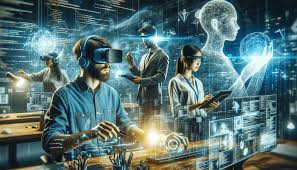Explore the cutting-edge technologies of virtual reality (VR) and augmented reality (AR) and their transformative potential in creating immersive experiences across various industries, from entertainment and gaming to education and healthcare.

Virtual reality (VR) and augmented reality (AR) are revolutionizing the way we interact with digital content, blurring the lines between the physical and virtual worlds and offering immersive experiences that engage our senses like never before. From immersive gaming and virtual tourism to interactive education and remote collaboration, VR and AR technologies are transforming industries and unlocking new possibilities for creativity, innovation, and exploration. In this comprehensive guide, we'll delve into the world of VR and AR, exploring their applications, benefits, challenges, and the exciting opportunities they present for the future of immersive experiences.
1. Understanding Virtual Reality and Augmented Reality: Virtual reality (VR) immerses users in a completely virtual environment, using headsets or goggles to simulate a 3D digital world that users can interact with and explore. Augmented reality (AR), on the other hand, overlays digital content onto the real world, enhancing our perception of reality by adding virtual objects, information, or experiences to our physical surroundings. Both VR and AR technologies offer unique ways to create immersive experiences and transport users to new realities, whether fictional or enhanced versions of the real world.
2. Applications of VR and AR:
Entertainment and Gaming: VR and AR have revolutionized the entertainment and gaming industry, offering immersive gaming experiences, interactive storytelling, and virtual theme park attractions. From immersive VR games and AR-enhanced mobile apps to location-based entertainment venues, VR and AR technologies are reshaping the way we play, engage, and entertain ourselves.
Education and Training: VR and AR are transforming education and training by providing immersive learning experiences, virtual simulations, and interactive training modules. From virtual field trips and historical reenactments to medical simulations and hands-on training for professionals, VR and AR technologies enhance learning outcomes, retention, and engagement across diverse educational settings.
Healthcare and Medicine: VR and AR technologies are revolutionizing healthcare and medicine by enabling virtual surgeries, medical training simulations, and patient rehabilitation programs. From surgical planning and telemedicine consultations to pain management therapies and exposure therapy for mental health disorders, VR and AR offer new tools and techniques for improving patient care, diagnosis, and treatment outcomes.
Architecture and Design: VR and AR are reshaping architecture and design processes by offering immersive visualization tools, virtual walkthroughs, and interactive design reviews. From architectural simulations and interior design visualizations to urban planning and real estate marketing, VR and AR technologies empower architects, designers, and clients to explore and interact with digital prototypes in a virtual environment.
3. Benefits of VR and AR:
4. Challenges and Considerations:
5. Future Trends in VR and AR:
Mixed Reality and Spatial Computing: Mixed reality (MR) combines elements of both VR and AR to create seamless transitions between virtual and real-world environments, enabling immersive experiences that blend digital and physical elements in real-time.
5G and Edge Computing: 5G networks and edge computing technologies enable low-latency, high-bandwidth connectivity, and real-time processing capabilities, enhancing the performance and scalability of VR and AR applications, particularly for streaming, multiplayer gaming, and remote collaboration.
AI and Machine Learning: AI and machine learning algorithms enhance VR and AR experiences by providing intelligent content recommendations, personalized interactions, and adaptive environments that respond to user behavior, preferences, and context.
Wearable Devices and Smart Glasses: Wearable devices and smart glasses offer new form factors and user interfaces for VR and AR experiences, enabling hands-free interaction, augmented reality overlays, and personalized notifications in everyday life.
Viral FAQs:
POVs (Points of View):
Are you curious about something? Are you intrested in our any Service or Product? Do you have some kind of problem with our Services or Products?
